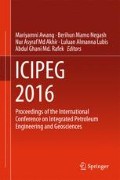Abstract
Reservoir connectivity is one of the main subsurface uncertainties in the assessment and improvement of many oil and gas fields. The main objective of this paper is to analyze the static and dynamic connectivity of the selected shallow-marine sandstone facies through construction of gridded-based units for flow behavior/patterns. Prior to the generation of the sandstone facies connectivity and flow simulation, outcrop log data are input into the modeling software. The exposer used for the facies connectivity and flow simulation was ranging from 1 to 500 cm. The measurements of permeability values were taken on each of the grid, which were bilinear extrapolated, to populate the surface with permeability variation. Detailed analysis of the sedimentology and interpretation of three major sandstone facies is used as a framework to build the geocellular facies connectivity and flow simulation. The sandstone facies of HCSS shows more uniform and have linear connectivity, fallow by sub-layer gridding. In case of HBCBS, horizontal sweep is more effective as compared to vertical, because of thin mudstone deposited at the base of each layer boundaries which resist to sweep vertically. Whereas TCBS, WFBS, and BS show the distribution of different qualities of sandstones and bioturbation in the grid block model, burrows filled with mud which acts as impermeable pathways within moderate to low-quality sandstone.
Access this chapter
Tax calculation will be finalised at checkout
Purchases are for personal use only
References
Abd Rahman, A. H., Menier, D., and Mansor, M. Y., 2014, Sequence stratigraphic modelling and reservoir architecture of the shallow marine successions of Baram field, West Baram Delta, offshore Sarawak, East Malaysia: Marine and Petroleum Geology.
Ainsworth, R. B., Flint, S. S., and Howell, J. A., 2008, Predicting coastal depositional style: influence of basin morphology and accommodation to sediment supply ratio within a sequence stratigraphic framework: Recent advances in models of shallow-marine stratigraphy: SEPM Special Publication, v. 90, p. 237–263.
Howell, J., Vassel, Å., and Aune, T., 2008, Modelling of dipping clinoform barriers within deltaic outcrop analogues from the Cretaceous Western Interior Basin, USA: Geological Society, London, Special Publications, v. 309, no. 1, p. 99–121.
Matthews, J. D., Carter, J. N., Stephen, K. D., Zimmerman, R. W., Skorstad, A., Manzocchi, T., and Howell, J. A., 2008, Assessing the effect of geological uncertainty on recovery estimates in shallow-marine reservoirs: the application of reservoir engineering to the SAIGUP project: Petroleum Geoscience, v. 14, no. 1, p. 35–44.
Stephen, K. D., Yang, C., Carter, J. N., Howell, J. A., Manzocchi, T., and Skorstad, A., 2008, Upscaling uncertainty analysis in a shallow-marine environment: Petroleum Geoscience, v. 14, no. 1, p. 71–84.
Enge, H. D., Buckley, S. J., Rotevatn, A., and Howell, J. A., 2007, From outcrop to reservoir simulation model: Workflow and procedures: Geosphere, v. 3, no. 6, p. 469–490.
Pranter, M. J., Ellison, A. I., Cole, R. D., and Patterson, P. E., 2007, Analysis and modeling of intermediate-scale reservoir heterogeneity based on a fluvial point-bar outcrop analog, Williams Fork Formation, Piceance Basin, Colorado: AAPG bulletin, v. 91, no. 7, p. 1025–1051.
Alpay, O. A., 1972, A practical approach to defining reservoir heterogeneity: Journal of Petroleum Technology, v. 24, no. 07, p. 841–848.
Hamilton, D., Reservoir Heterogeneity at Seventy-Six West Field Texas: An Opportunity for Increased Oil Recovery From Barrier/Strandplain Reservoirs of the Jackson-Yegua Trend by Geologically Targeted Infill Drilling, in Proceedings SPE Annual Technical Conference and Exhibition 1991, Society of Petroleum Engineers.
Meyer, R., and Krause, F. F., 2006, Permeability anisotropy and heterogeneity of a sandstone reservoir analogue: An estuarine to shoreface depositional system in the Virgelle Member, Milk River Formation, Writing-on-Stone Provincial Park, southern Alberta: Bulletin of canadian petroleum geology, v. 54, no. 4, p. 301–318.
Morad, S., Al-Ramadan, K., Ketzer, J. M., and De Ros, L., 2010, The impact of diagenesis on the heterogeneity of sandstone reservoirs: A review of the role of depositional facies and sequence stratigraphy: AAPG bulletin, v. 94, no. 8, p. 1267–1309.
Willis, B. J., and White, C. D., 2000, Quantitative outcrop data for flow simulation: Journal of Sedimentary Research, v. 70, no. 4.
Wilson, M. D., 1994, Diagenetic mechanisms of porosity and permeability reduction and enhancement.
White, C. D., Willis, B. J., Dutton, S. P., Bhattacharya, J. P., and Narayanan, K., 2004, Sedimentology, statistics, and flow behavior for a tide-influenced deltaic sandstone, Frontier Formation, Wyoming, United States.
Pringle, J., Howell, J., Hodgetts, D., Westerman, A., and Hodgson, D., 2006, Virtual outcrop models of petroleum reservoir analogues: a review of the current state-of-the-art: First break, v. 24, no. 3.
Acknowledgements
The authors gratefully acknowledge Universiti Teknologi PETRONAS and PETRONAS Sdn. Berhad for their financial support and funding for this research activity. However, the technical contents and ideas presented in this paper are solely the author’s interpretations.
Author information
Authors and Affiliations
Corresponding author
Editor information
Editors and Affiliations
Rights and permissions
Copyright information
© 2017 Springer Nature Singapore Pte Ltd.
About this paper
Cite this paper
Siddiqui, N.A., Rahman, A.H.A., Sum, C.W. (2017). Bilinear Extrapolation for Geocellular Reservoir Connectivity and Flow Simulation. In: Awang, M., Negash, B., Md Akhir, N., Lubis, L., Md. Rafek, A. (eds) ICIPEG 2016. Springer, Singapore. https://doi.org/10.1007/978-981-10-3650-7_36
Download citation
DOI: https://doi.org/10.1007/978-981-10-3650-7_36
Published:
Publisher Name: Springer, Singapore
Print ISBN: 978-981-10-3649-1
Online ISBN: 978-981-10-3650-7
eBook Packages: EnergyEnergy (R0)

